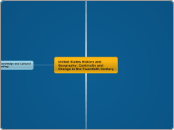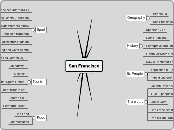United States History and Geography: Continuity and Change in the Twentieth Century
Goal of Knowledge and Cultural Understanding
Sociopolitical Literacy
11.11.7 Explain how the federal, state, and local governments have responded to demographic and social changes such as population shifts to the suburbs, racial concentrations in the cities, Frostbelt-to-Sunbelt migration, international migration, decline of family farms, increases in out-of-wedlock births, and drugs.
11.11.6 Analyze the persistence of poverty and how different analyses of this issue influence welfare reform, health insurance reform, and other social policies.
11.10.2 Examine and analyze the key events, policies, and court cases in the evolution of civil rights, including Dred Scott v Sandford, Plessy v Ferguson, Brown v Board of education, Regents of the University of California v Bakke, and California Proposition 209.
The Supreme Court in Brown v Board of Education (1954)
a. permitted affirmative action in admission to colleges
b. ended Bible reading and prayer in public schools
c. outlawed racial segregation in public schools
d. authorized schools to censor student newspapers
Economic Literacy
11.8.2 Describe the significance of Mexican immigration and its relationship to the agricultural economy, especially in Califorinia.
During the second half of the twentieth century, the largest source of labor in California agriculture was
a. unemployed Midwestern industrial workers
b. relocated Southern sharecroppers
c. displaced workers from the Plains states
d. immigrants from Mexico
11.6.2 Understand the explanations of the principle causes of the Great Depression and the steps taken by the Federal Reserve, Congress, and President Herbert Hoover and Franklin Delano Roosevelt to combat the economic crisis.
11.6.1 Describe the monetary issues of the late nineteenth and early twentieth centuries that gave rise to the establishment of the Federal Reserves and the weaknesses in the key sectors of the economy in the late 1920s.
Geographic Literacy
11.9.3 Trace the origins and geopolitical consequences (foreign and domestic) of the Cold War and containment policy, including the following:
a. the era of McCarthyism, instances of domestic Communism (eg. Alger Hiss) and blacklisting
b. The Truman Doctrine
c. The Berlin Blockage
d. The Korean War
e. The Bay of Pigs Invasion and the Cuban Missile Crisis
f. Atomic testing in the American West, the "mutual assured destruction" doctrine, and disarmament policies
g. The Vietnam War
h. Latin American policy
11.6.3 Discuss the human toll of the Depression, natural disasters, and unwise agricultural practices and their effects on the depopulation of rural regions and on political movements of the left and right, with particular attention to the Dust Bowl refugees and their social and Economic impacts in California.
To many Californians, the arrival of the Dust Bowl refugees of the mid-1930s represented
a. a welcome addition to the labor force
b. a source of much-needed capital investment
c. new markets for California businesses
d. unwanted additions to the ranks of the unemployed
11.2.6 Trace the economic development of the United States and its emergence as a major industrial power, including its gains from trade and the advantages of its physical geography.
Cultural Literacy
11.8.8 Discuss the forms of popular culture, with emphasis on their origins and geographic diffusion (eg. jazz and other forms of popular music, professional sports, architectural and artistic styles).
11.5.6 Trace the growth and effects of radio and movies and their role in the worldwide diffusion of popular culture.
11.5.5 Describe the Harlem Renaissance and new trends I literature, music, and art, with special attention to the work of writers (eg. Zora Neale Hurston, Langston Hughes).
The primary objective of the Harlem Renaissance writers was to
a. encourage military protest among African Americans
b. support educational programs for African Americans
c. improve literacy rates among African Americans
d. generate pride in African American culture
Ethical Literacy
11.10.3 Describe the collaboration on legal strategy between African American and White civil rights lawyers to end racial segregation in higher education.
11.7.7 Discuss the decision to drop atomic bombs and the consequences of the decision (Hiroshima and Nagasaki).
11.7.5 Discuss the constitutional issues and impact of events on the U.S. home front, including the internment of Japanese Americans (eg. Fred Korematsu v United States of America) and the restrictions on German and Italian resident aliens; the response of the administration to Hitler's atrocities against Jews and other groups; the roles of women in military production; and the roles and growing political demands of African Americans.
Partly because Japanese Americans living on the West Coast during World War II were considered security risks, they were
a. forced to give up their US citizenship
b. barred from military service throughout the war
c. moved from their homes to internment camps
d. prohibited by law from seeking employment with the federal government.
Historic Literacy
11.10.5 Discuss the diffusion of the civil rights movement of African Americans from the church's of the rural South and the urban North, including the resistance of racial desegregation in Little Rock and Birmingham, and how the advances influenced the agendas, strategies, and effectiveness of the quests of American Indians, Asian Americans, and Hispanic Americans for civil rights and equal opportunities.
11.5.2 Analyze the international and domestic events, interests, and philosophies that prompted attacks on civil liberties, including the Palmer Raids, Marcus Garvey's "back-to-Africa" movement, the Ku Klux Klan, and immigration quotas and the responses of organizations such as the American Civil Liberties Union, the National Association for the Advancement of Colored People, and the Anti-Defamation League to those attacks.
Reconstruction comes to an end in the south > White government officials regain power of the South > Southern states begin to implement poll taxes, literacy tests, and grandfather clauses.
During the late 19th century, the above sequence of events resulted in the
a. disfranchisement of most African Americans in the South
b. movement to repeal the 14th Amendment to the Constitution
c. Strengthening of the Republican Party in the South
d. Expansion of free public education
11.4.6 Trace the declining role of Great Britain and the expanding role of the United States in world affairs after World War II.
Goal of Skills Attainment and Social Participation
Basic Study Skills
CCSS.ELA Literacy WHST 11-12.8 Gather relevant information form multiple authoritative print and digital sources, using advanced searches effectively; assess the strengths and limitations of each source in terms of the specific task, purpose, and audience; integrate information into the text selectively to maintain the flow of ideas, avoiding plagiarism and overreliance on any one source and following a standard format for citation.
CCSS.ELA Literacy RH 11-12.7 integrate and evaluate multiple sources of information presented I. diverse formats and media (eg. visually, quantitatively, as well as in words) in order to address a question or solve a problem.
CCSS.ELA Literacy RH 11-12.4 Determine the meaning of words and phrases as they are used in a text, including analyzing how an author uses and refines the meaning of a key term over the course of a text (eg. how Madison defines faction in Federalist No 10).
Critical Thinking Skills
CCSS.ELA Literacy WHST 11-12.1 Writing arguments focused on discipline-specific content.
a. introduce precise, knowledgeable claim(s), establish the significance of the claim(s), distinguish the claim(s) from alternate or opposing claims, and create an organization that logically sequences the claim(s), counterclaims, reasons, and evidence
b. Develop claim(s) and counterclaims fairly and thoroughly, supplying the most relevant data and evidence for each while pointing out the strengths and limitations, of both claim(s) and counterclaims in a discipline-appropriate form that anticipates the audience's knowledge level, concerns, values, and possible biases
c. Use words, phrases, and clauses as well ass varied syntax to link the major sections of the text, create cohesion, and clarify the relationships between claim(s) and reasons, between reasons and evidence, and between claim(s) and counterclaims.
d. Establish and maintain a formal style and objective tone while attending to the norms and conventions of the discipline in which they are writing.
e. Provide a concluding statement or section that follows from or supports the argument presented.
CCSS.ELA Literacy RH 11-12.8 Evaluate an author's premises, claims, and evidence by corroborating or challenging them with other information.
CCSS.ELA Literacy RH 11-12.5 Analyze in detail how a complex primary source is structured, including how key sentences, paragraphs, and larger portions of the text contribute to the whole.
Participation Skills
CCSS.ELA Literacy WHST 11-12.7 Conduct short as well as more sustained research projects to answer a question (including a self-generated question) or solve a problem; narrow or broaden the inquiry when appropriate; synthesize multiple sources on the subject, demonstrating understanding of the subject under investigation.
CCSS.ELA Literacy WHST 11-12.4 Produce clear and coherent writing in which the development, organization, and style are appropriate to task, purpose, and audience.
CCSS.ELA Literacy RH 11-12.9 Integrate information from diverse sources, both primary and secondary, into a coherent understanding of an idea or event, noting discrepancies among sources.
Goal of Democratic Understanding and Civic Value
Civic Value, Rights, and Responsibility
11.10.6 Analyze the passage and effects of civil rights and voting rights legislation (eg. 1946 Civil Rights Act, Voting Rights Act of 1965) and the Twenty-Fourth Amendment, with an emphasis on equality of access to education and to the political process.
11.10.4 Examine the roles of civil rights advocates (eg., A. Philip Randolph, Martin Luther King Jr., Malcolm X, Thurgood Marshall, James Farmer, Rosa Parks), including the significance of Martin Luther King Jr.'s "Letter from Birmingham Jail" and "I Have a Dream" speech.
11.5.4 Analyze the passage of the Nineteenth Amendment and the changing role of women in society.
Constitutional Heritage
11.3.5 Describe the principles of religious liberty found in the Establishment and Free Exercise Clause of the First Amendment, including the debate on the issue of separation of church and state.
11.1.3 Understand the history of the Constitution after 1787 with emphasis on federal versus state authority and growing democratization.
11.1.2 Analyze the ideology origins of the American Revolution, the Founding Fathers' philosophy of divinely bestowed unalienable natural rights, the debates on the drafting and ratification of the Constitution, and the addition of the Bill of Righhts.
National Identity
11.11.3 Describe the changing roles of women I society as reflected in the entry of more women into the labor force and the changing family structure.
11.10.7 Analyze the women's rights movement from the era of Elizabeth Cady Stanton and Susan B Anthony and the passage of the Nineteenth Amendment to the movement launched in the 1960s, including differing perspectives on the roles of women.
11.3.4 Discuss the expanding religious pluralism in the United States and California that resulted from large-scale immigration in the twentieth century.









